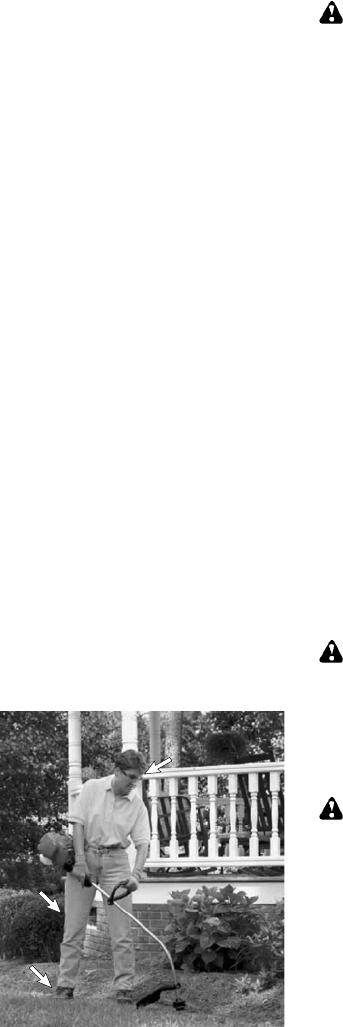
8
gine doesn’t start after 6 pulls (at the HALF
CHOKE position), move the choke lever to
the FULL CHOKE position and press the
primer bulb 6 times. Squeeze and hold the
throttle trigger and pull the starter rope 2
more times. Move th e choke le ver to the
HALF CHOKE p osition and pull t he starter
rope untiltheengineruns, but nomore than
6 pulls. If the engine still doesn’t start, it is
probably flooded. Proceed to ST ARTING A
FLOODE D ENGINE.
8. Once theengine starts,allow ittorun10 se-
conds, then move the choke lever to the
RUN position. Allow the unit to run for 30
more seconds atRUN before releasing the
throttletrigger.
NOTE:Ifengine dieswith
the choke lever in the RUN position,
move the choke lever to the HALF
CHOKE position and pull the rope until
engine runs, but no more than 6 pulls.
STARTING A WARM ENGINE
1. Move thechoke lever tothe HALF CHOKE
position.
2. Squeeze and hold the throttle trigger . Keep
throttle trigger fully squeezed until the en-
gine runs smoothly .
3. Pull starter rope sharply until engine runs,
but no m ore than 6 pulls.
4. Allow engineto run 15seconds, thenmove
thechokelevertoRUN.
NOTE: If enginehas not started, pullstarter
rope5morepulls.Ifenginestilldoesnotrun,it
is probably flooded.
STARTING A FLOODED ENGINE
Floodedenginescanbestartedbyplacingthe
chokelever inthe RUNposition;then, pullthe
rope to clear the engine of e xcess fuel. This
could require pulling the starter handle many
times depending on how badly the unit is
flooded. If the unit still doesn’t start, refer to
TROUBLESHOOTING TABLE or call
1-800-554-6723.
OPERATING INSTRUCTIONS
It is recommended that the engine not b e
operated for longer than 1 minute at full
throttle.
OPERA TING POSITION
Cutfromyour rightto yourleft.
ALWAYS
WEAR:
Long
Pants
Heavy
Shoes
Eye protection
WARNING: Always wear hearing
protection and eye protection. Never lean
over the trimmer head. Rocks or debris can
ricochet or be thrown into eyes and face and
cause blindness or other serious injury.
Do not run the engine at a higher speed than
necessary. The cutting line will cut efficiently
when the engine is run at less than full throttle.
At lower speeds, there is less engine noise and
vibration. The cutting line will last longer and will
be l ess likely to “weld” onto the spoo l.
Always release the throttle trigger and allow the
engine to return to idle speed when not cutting.
To stop engine:
S Release the throttle trigger.
S Push and hold the STOP switch in the
STOP position until the engine stops.
TRIMMER LINE A DVAN CE
Thetrimmerlinewilladvanceapproximately2
inches ( 5 cm) each time the bottom of the
trimmerheadis tappedonthegroundwiththe
engine running at full throttle.
The most ef ficient line length is the maximum
length allowed by the line limiter .Always keep
the shield in place when the tool is being oper-
ated.
To advance line:
S Operate the engine at full throttle.
S Holdthetrimmerheadparalleltoandabove
the grassy area.
S Tap the bottom of the trimm er head lightly
on the ground one time. Approximately 2
inches (5 cm) of line will be advanced with
each tap.
Always tap the trimmer head on a g rassy
area. Tapping on surfaces such as concrete
or asphalt can cause excessive wear to the
trimmer head.
If the line is worn down to 2 inches (5 cm) or
less, morethan onetapwill berequired toob-
tain the most efficient line length.
WARNING: Use only 0.080 inch (2
mm) diameter line. Other sizes of line will not
advance properly and will result in improper
cutting head function or can cause serious
injury. Do not use other materials such as
wire, string,rope,etc. Wire can break of fdur-
ing cutting and become a dangerous missile
that can cause serious injury .
CUTTING METHODS
WARNING: Use minimum speed
anddonotcrowdthelinewhencuttingaround
hard objects (rock, gravel, fence posts,etc.),
whichcandamagethetrimmerhead,become
entangled in the line, or be thrown causing a
serious hazard.
S Thetip of the line does thecutting. Yo uwill
achieve t he best performance and mini-
mumline wear bynot crowdingthe lineinto
the cutting area. The right and wrongways
are shown below.
















